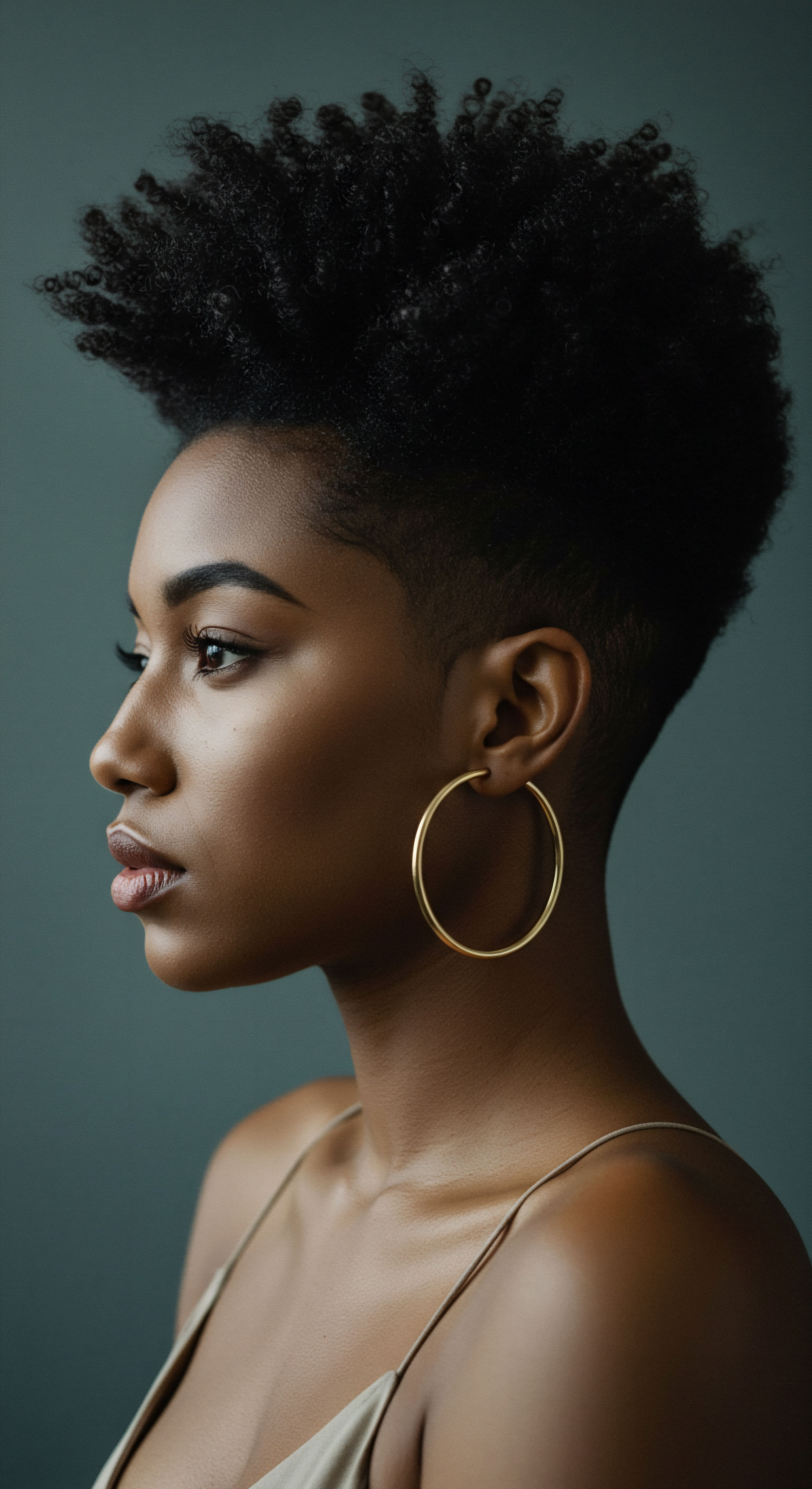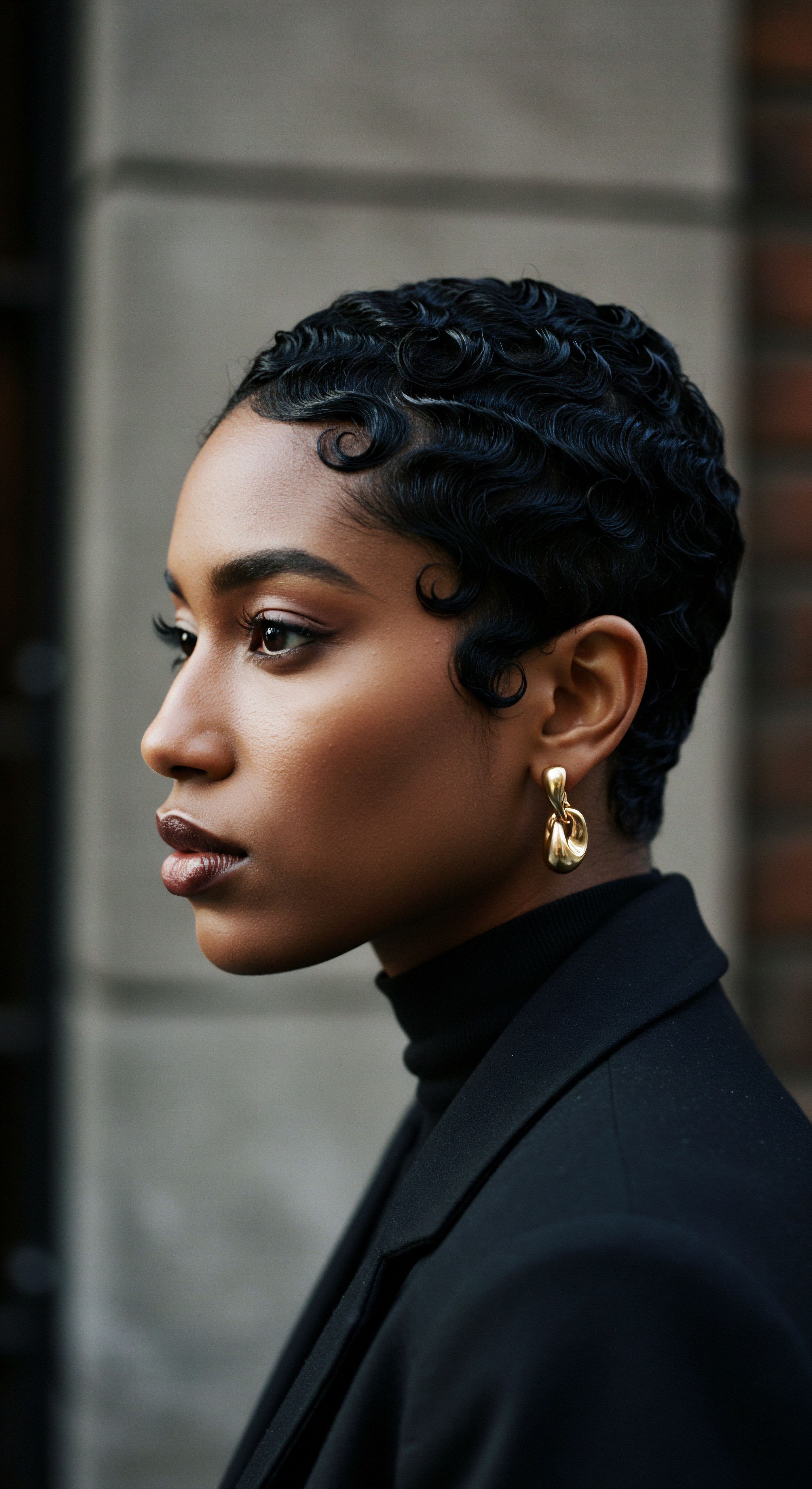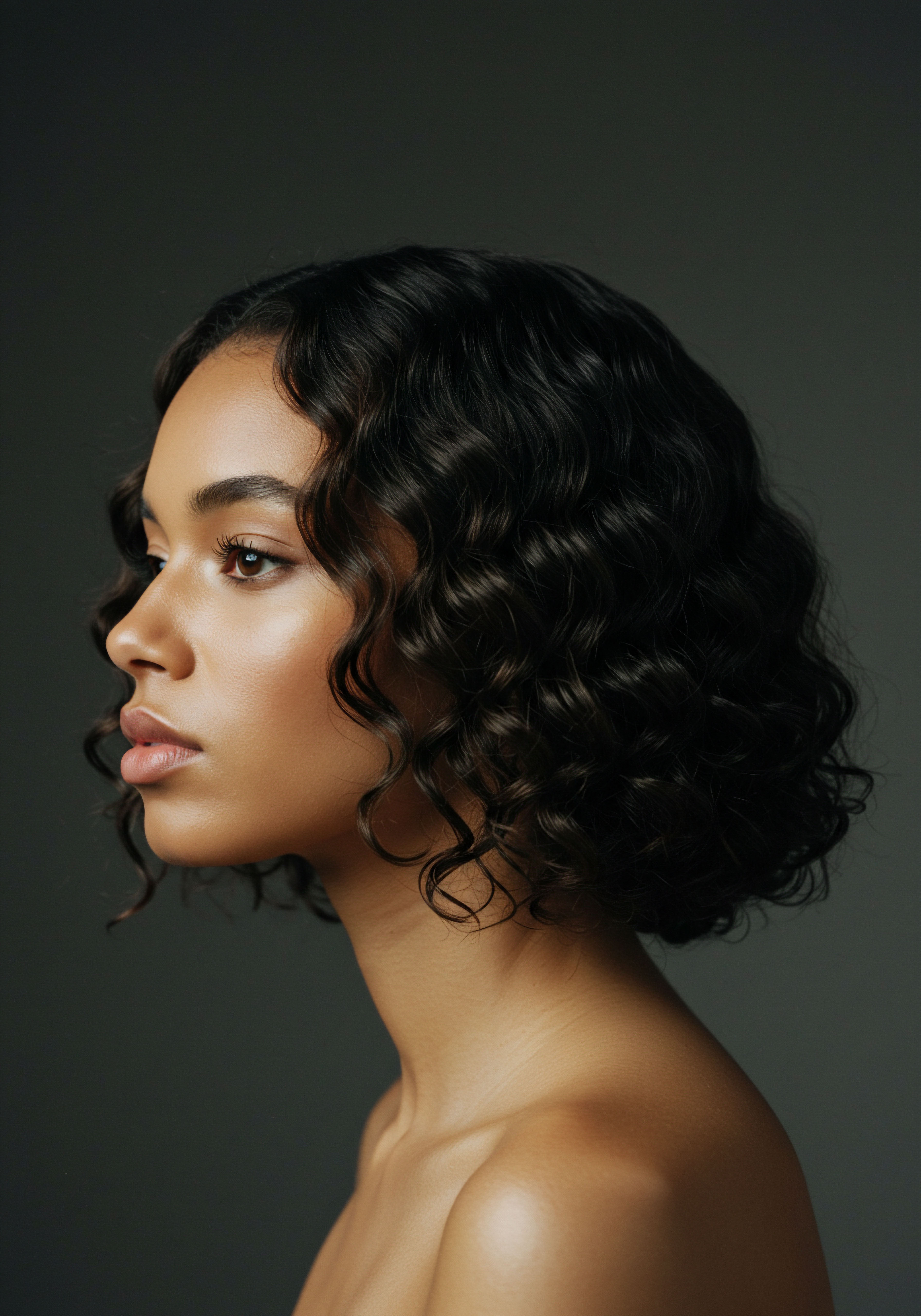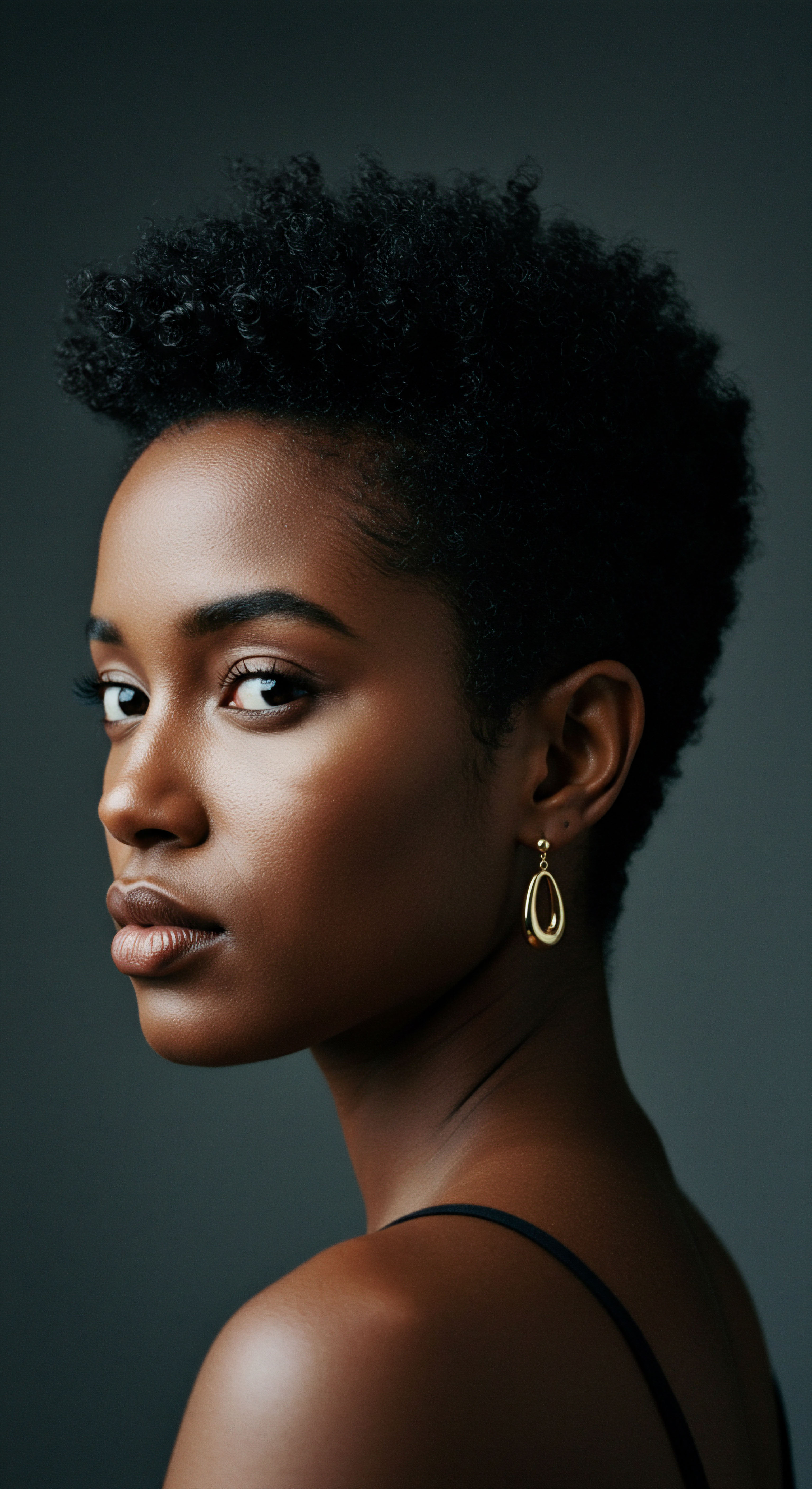
Roots
The quiet hum of water, a sound so commonplace in our daily rituals, often goes unnoticed, yet it forms the very bedrock of countless practices, including the cleansing of our hair. To consider waterless hair care products, one must first pause and reflect upon the elemental connection between water and our strands, a bond stretching back through generations, across diverse cultures. It is a relationship shaped not only by practicality but by the very structure of hair itself, particularly textured hair, which holds unique conversations with moisture. This deep connection, often taken for granted, grounds our understanding of why a shift away from water might carry significant meaning, far beyond a simple product change.

Hair Anatomy and Its Affinity for Water
At its very core, a strand of hair is a complex biological structure, a miniature marvel. The outermost layer, the Cuticle, resembles overlapping scales, much like shingles on a roof. These cuticular scales, when healthy, lie flat, reflecting light and offering protection. Beneath this protective shield lies the Cortex, the primary bulk of the hair, composed of keratin proteins that give hair its strength and elasticity.
For textured hair, this architecture presents itself with particular curvatures and varying degrees of cuticle lift. These natural bends and coils mean the cuticle is not always uniformly flat, leading to a greater propensity for moisture loss and, conversely, a greater thirst for hydration.
Water acts as a solvent, a carrier, and a vital hydrating agent for hair. When water meets hair, it can penetrate the outer cuticle, reaching the cortex. This absorption, while temporarily plumping the hair shaft, can also lead to hygral fatigue, a cycle of swelling and shrinking that may compromise the hair’s structural integrity over time, particularly for highly porous or delicate strands. The way water interacts with textured hair, influencing its curl pattern and overall feel, is a nuanced dance, one that traditional water-laden products have long sought to manage, often with varying degrees of success.

Early Cleansing Without Abundant Water
Before the advent of modern liquid shampoos, which typically consist of 70-80% water, and for rinse-off products even up to 95% water, people around the world employed resourceful methods for hair hygiene. These practices, often born from necessity or cultural wisdom, relied on ingredients that minimized or eliminated the need for copious amounts of water for the cleansing process itself. In ancient India, for example, Ayurvedic traditions saw the use of herbal pastes made from boiled reetha (Indian soapberry), amla (gooseberry), and shikakai (acacia) to clean and condition the hair. These botanical wonders possessed natural saponins, gentle cleansing agents that required less water for activation and rinsing than contemporary formulations.
Across different continents, ingenuity led to similar water-conserving approaches. Ancient Egyptians used citrus juice and oils, while Greeks and Romans sometimes relied on vinegar rinses to refresh their hair. In North Africa, rhassoul clay served as a cleansing agent, mixed with just enough water to create a workable paste.
These historical methods demonstrate a profound understanding of hair’s needs and the limitations of environmental resources, offering a silent testament to the efficacy of less water-intensive routines. They remind us that the idea of water-free hair care is not a recent innovation, but rather a rediscovery of ancestral wisdom, adapting it to modern contexts.
Hair’s inherent structure, especially for textured strands, dictates a unique interaction with water, shaping how moisture is absorbed and retained.
The practices of the past, often necessitated by limited access to clean, running water, highlight a pragmatic approach to hair care. Medieval Europe, for instance, saw people using dry detangling with combs and brushes, sometimes supplemented with powders, to manage hair cleanliness, as widespread access to clean water for frequent washing was not common. This historical perspective offers a compelling counterpoint to the modern expectation of daily water-intensive washing, showing that clean, healthy hair was maintained through alternative means. It suggests that our current reliance on water-heavy products is a relatively recent development, rather than an unchanging constant in hair care history.

Ritual
Stepping into the realm of waterless hair care means examining the established rituals we hold dear, those routines that define our cleansing and conditioning moments. It asks us to consider whether these practices, steeped in tradition and convenience, align with a broader awareness of our planet’s resources. The transition to waterless products is not merely a change in bottle shape; it represents a gentle shift in how we approach our personal care, inviting us to reconnect with the intention behind each step, and to ask if less can truly be more.

Rethinking the Cleansing Routine
Traditional liquid shampoos and conditioners, with their high water content, have shaped our hair care habits for decades. The satisfying lather, the sensation of water rinsing through strands—these elements have become synonymous with cleanliness. Yet, this reliance on water carries a significant environmental footprint.
Beyond the water present in the product itself, a considerable amount is used during the consumer’s wash and rinse cycles. A single shower, for instance, can consume substantial volumes of water, with rinsing contributing a notable portion.
Waterless hair care products, such as solid bars, powders, or concentrated oils, offer a compelling alternative. These formulations bypass the need for water as a primary ingredient, thereby reducing the “formula water” that contributes to the product’s overall weight and volume. This inherent characteristic translates into several environmental advantages.
- Concentrated Formulations ❉ Waterless products are often highly concentrated, meaning a smaller amount of product can achieve the same, or even better, results than a larger quantity of its liquid counterpart. This density means consumers use less product per application, extending the product’s lifespan.
- Reduced Packaging Waste ❉ Without the need for bulky liquid, waterless products frequently come in solid forms that require minimal or no plastic packaging, often opting for recyclable or compostable materials. This addresses a significant environmental challenge within the beauty industry, where billions of pieces of packaging are produced annually, with a large percentage ending up as waste.
- Lower Carbon Footprint from Transport ❉ The reduced weight and volume of waterless products translate to fewer emissions during shipping and distribution. Lighter shipments require less energy, contributing to a smaller carbon footprint across the supply chain.

Are Waterless Products Effective for Textured Hair?
A common query surrounding waterless products, particularly for those with textured hair, revolves around their efficacy. Textured hair often requires significant moisture and gentle cleansing to prevent dryness and breakage. The good news is that many waterless formulations are specifically designed to address these needs.
Solid shampoo bars, for instance, can be crafted with moisturizing agents and gentle surfactants to cleanse without stripping natural oils. Dry shampoos, while not a substitute for a full wash, can extend the time between washes, offering a refresh without any water.
The composition of these products is key. Many waterless options prioritize natural, plant-based, and sustainably sourced ingredients. This often means formulations free from harsh chemicals or synthetic additives that might otherwise contribute to water pollution when rinsed away. The focus shifts to ingredients that provide conditioning, scalp care, and cleansing properties in a concentrated, water-free matrix.
Waterless hair care redefines our routines by offering concentrated products that minimize water use, packaging waste, and transportation emissions.
The adaptability of waterless products means they can be integrated into various hair care regimens. For textured hair, this could involve using a solid cleansing bar for a gentle wash, followed by a concentrated oil or balm for conditioning and styling. The emphasis moves from a water-heavy process to one where water is used mindfully, perhaps only for initial wetting or final rinsing, rather than as a primary component of the product itself. This thoughtful approach can help preserve the hair’s natural moisture balance while simultaneously reducing environmental impact.

Can a Waterless Routine Truly Conserve Resources?
The question of whether waterless products truly reduce environmental impact extends beyond the product formulation to the consumer’s use habits. While the product itself contains no water, the act of washing hair still requires water. However, waterless formulations can significantly reduce the total water consumption associated with hair care. For instance, a life cycle assessment of shampoo often reveals that the consumer use phase, particularly the energy required to heat water, accounts for the largest portion of its environmental impact, sometimes as high as 90% of CO2 emissions.
By making products that rinse more easily or require less water to activate, waterless options can contribute to a reduction in shower time and, consequently, water and energy consumption. Even a slight reduction in shower duration can lead to substantial water savings over time. For example, shaving just 30 seconds off each hair wash can save over 2,000 liters of water per person annually. This highlights a compelling synergy ❉ waterless products reduce the water footprint of the product itself, and they can also subtly encourage more water-conscious habits in the consumer.
| Aspect Water Content |
| Traditional Liquid Products Typically 70-85%, up to 95% for rinse-off |
| Waterless Alternatives Minimal to none in formulation |
| Aspect Packaging Implications |
| Traditional Liquid Products Often plastic bottles, high waste volume |
| Waterless Alternatives Reduced plastic, often solid forms, recyclable |
| Aspect Transportation Weight |
| Traditional Liquid Products Heavier due to water content, higher emissions |
| Waterless Alternatives Lighter, lower carbon footprint |
| Aspect Preservative Needs |
| Traditional Liquid Products Higher need due to water presence |
| Waterless Alternatives Reduced or eliminated due to low water activity |
| Aspect This comparison illustrates the direct benefits of waterless formulations across their lifecycle. |

Relay
Beyond the tangible benefits of reduced water and packaging, the discussion of waterless hair care invites a deeper look into the intricate connections between our personal choices, industrial practices, and the delicate balance of our shared environment. This is where the conversation expands, touching upon global water scarcity, consumer psychology, and the profound shifts within the beauty industry. It asks us to consider not only what we apply to our hair, but the ripples of impact that extend far beyond our bathroom walls.

Considering the Global Water Landscape
The notion of water abundance, once a given in many parts of the world, is steadily giving way to a starker reality ❉ freshwater is a finite and increasingly precious resource. Over 2 billion people currently live in countries experiencing high water stress, a figure expected to worsen with climate shifts and population growth. The beauty industry, while perhaps not immediately recognized as a major water consumer, utilizes a significant volume.
Approximately 120 billion liters of water are believed to be used by the beauty industry each year. This includes water used in ingredient cultivation, manufacturing processes, and as a primary ingredient in product formulations.
A particularly compelling, and perhaps surprising, statistic reveals the hidden environmental toll of our hair care habits ❉ the consumer use phase of shampoo, specifically the energy required to heat water for washing, accounts for up to 90% of its total CO2 emissions throughout its entire life cycle. This figure, often overlooked in discussions about product sustainability, underscores that while waterless products reduce the water content of the formula itself, the greatest environmental impact often lies in how consumers use these products at home. This suggests that promoting waterless formulations must be coupled with a broader awareness campaign about water temperature and duration of washing.
The true environmental impact of hair care extends beyond product ingredients to include the significant energy used for heating water during consumer washes.

Do Consumer Attitudes Drive Sustainable Product Adoption?
The journey toward waterless hair care also navigates the complex terrain of consumer behavior. While interest in sustainable products is growing, with 69% of women reportedly interested in waterless beauty products, particularly solid forms, there often exists an “attitude-behavior gap”. People may express a desire for environmentally friendly options, yet their purchasing habits do not always align perfectly with these intentions. This gap can stem from various factors, including perceived product effectiveness, price points, availability, and ingrained habits.
For waterless hair care to truly reduce environmental impact on a large scale, it requires a shift in consumer perception and habit. Brands must not only offer effective waterless alternatives but also clearly communicate the benefits—both for the hair and the planet. This involves educating consumers on how to use these products, dispelling myths about their efficacy, and perhaps even reframing the “ritual” of hair care to emphasize conscious consumption over traditional, water-heavy practices. Success depends on making the sustainable choice the easy and desirable choice, rather than a compromise.

Waterless Products and the Future of Textured Hair Care
For textured hair, the conversation around waterless products gains another layer of significance. Historically, many communities with textured hair have relied on less frequent washing and more oil-based or dry conditioning methods, sometimes out of necessity, sometimes out of cultural tradition. These practices, such as the use of rice water rinses by the Yao women of Huangluo village in China for incredibly long hair, demonstrate long-standing methods that minimize water usage while prioritizing hair health. The return to waterless or low-water methods in modern hair care can be seen as a respectful nod to these ancestral approaches, aligning contemporary sustainability goals with deeply rooted cultural wisdom.
The formulation science behind waterless products for textured hair is constantly progressing. Formulators are developing solid bars and concentrated serums that deliver essential moisture, slip, and cleansing without dilution. This innovation allows for products that are not only environmentally gentler but also potentially more potent, as active ingredients are not diluted by water. The reduced need for preservatives, as water is a breeding ground for microbes, is another significant benefit, leading to cleaner formulations for the hair and scalp.
- Concentrated Actives ❉ Waterless formulations can contain a higher concentration of beneficial ingredients, delivering more targeted care with less product.
- Reduced Preservatives ❉ Without water, the need for broad-spectrum preservatives diminishes, leading to simpler, often gentler, ingredient lists.
- Portability ❉ Solid or powdered forms are ideal for travel, reducing spills and complying with liquid restrictions.

What are the Systemic Challenges to Widespread Waterless Adoption?
Despite the clear advantages, the widespread adoption of waterless hair care products faces systemic challenges. One significant hurdle is the established infrastructure of manufacturing and distribution, which is largely set up for liquid products. Re-tooling factories, re-educating supply chains, and altering retail displays require substantial investment and strategic shifts. There is also the matter of consumer perception, where the visual cue of a foamy lather, heavily associated with cleanliness, can be difficult to overcome for products that perform differently.
Regulatory frameworks also play a role. While waterless products may reduce certain environmental impacts, they still need to meet safety and efficacy standards. Research into the long-term effects of various waterless formulations on hair and scalp health, especially for diverse hair types, is ongoing. Collaboration between cosmetic chemists, environmental scientists, and cultural practitioners is essential to ensure that this movement is genuinely sustainable and beneficial for all.
| Life Cycle Stage Raw Material Sourcing |
| Primary Environmental Concern Land use, water consumption for cultivation |
| Relative Contribution (Approximate) 12% of product footprint, 30-50% of emissions |
| Life Cycle Stage Manufacturing |
| Primary Environmental Concern Energy consumption, wastewater |
| Relative Contribution (Approximate) Significant, but less than use phase |
| Life Cycle Stage Packaging Production |
| Primary Environmental Concern Plastic waste, energy for production |
| Relative Contribution (Approximate) 35% of product footprint, major waste challenge |
| Life Cycle Stage Distribution |
| Primary Environmental Concern Carbon emissions from transport |
| Relative Contribution (Approximate) Lower than other stages, but present |
| Life Cycle Stage Consumer Use |
| Primary Environmental Concern Water heating energy, water consumption |
| Relative Contribution (Approximate) Up to 90% of CO2 emissions, 60% of water footprint |
| Life Cycle Stage Product End-of-Life |
| Primary Environmental Concern Wastewater contamination, packaging disposal |
| Relative Contribution (Approximate) Pollution from chemicals, microplastics |
| Life Cycle Stage The consumer use phase, driven by hot water, often dominates the overall environmental impact of traditional shampoos. |

Reflection
The path toward waterless hair care is more than a trend; it is a thoughtful re-evaluation of our relationship with precious resources and our daily routines. It asks us to look beyond the immediate convenience and consider the wider environmental impact of our choices. While the journey is complex, requiring shifts in both industry and individual habits, the potential for positive change is substantial. This movement offers a quiet invitation to rediscover the wisdom of simpler practices, honoring both our hair and the planet that sustains us.

References
- Aguiar, J. B. Martins, A. M. Almeida, C. Ribeiro, H. M. & Marto, J. (2022). Water sustainability ❉ A waterless life cycle for cosmetic products. Sustainable Production and Consumption, 32, 35-51.
- Hoekstra, A. Chapagain, A. Aldaya, M. & Mekonnen, M. (2011). The Water Footprint Assessment Manual ❉ Setting the Global Standard Practically. Earthscan Ltd.
- Lukić, M. & Krajišnik, D. (2024). Challenges and advances in waterless cosmetic product development – raising awareness of water sustainability. Archives of Pharmacy.
- Martins, A. M. & Marto, J. M. (2023). A sustainable life cycle for cosmetics ❉ From design and development to post-use phase. Sustainable Chemistry and Pharmacy, 35, 101178.
- Van Holt, T. Statler, M. Atz, U. Whelan, T. van Loggerenberg, M. & Cebulla, J. (2020). The cultural consensus of sustainability-driven innovation ❉ Strategies for success. Business Strategy and the Environment, 29, 3399–3409.
- Wüest, R. Hellweg, S. & Frischknecht, R. (2025). Life Cycle Assessment of a Plant-Based, Regionally Marketed Shampoo and Analysis of Refill Options. MDPI.
- Fu, L. Huang, S. & Li, Y. (2018). The effect of environmental awareness on consumer behavior of eco-friendly product. International Journal of Business and Management, 13(10), 125-132.
- Grob, A. (1995). A structural model of environmental attitudes and behaviour. Journal of Environmental Psychology, 15(3), 209–220.
- Aguiar, J. B. & Martins, A. M. (2022). Waterless cosmetic products ❉ A sustainable life cycle. Sustainable Production and Consumption, 32, 35-51.
- Brito, R. C. Fernandes, I. P. & Marto, J. M. (2023). Sustainable formulations for a shampoo bar containing mango peel extracts as antioxidants. Cosmetics, 10(4), 95.